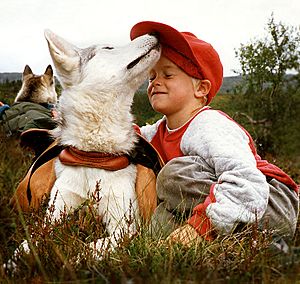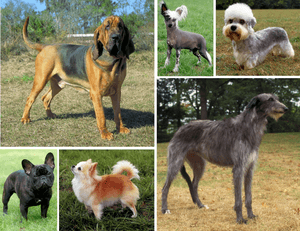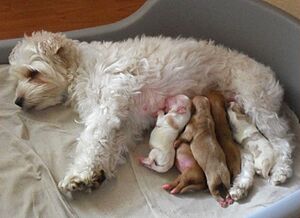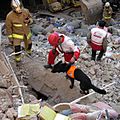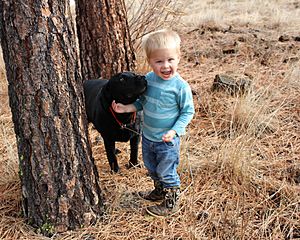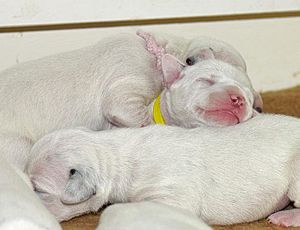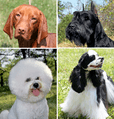Dog facts for kids
Quick facts for kids Domestic dog |
|
|---|---|
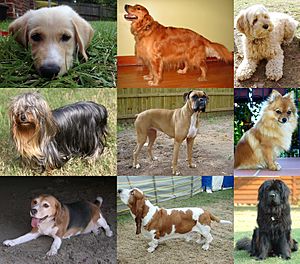 |
|
| Nine different breeds of dogs | |
| Conservation status | |
| Scientific classification | |
| Kingdom: | |
| Class: | |
| Order: | |
| Family: | |
| Genus: | |
| Species: | |
| Subspecies: |
C. l. familiaris
|
Dogs (Canis lupus familiaris) are domesticated mammals. This means they are not wild animals. Dogs were first bred from wolves by humans. The word "canine" comes from the Latin word canis, which means dog. Sometimes, people use "dog" to talk about other canids, like wolves.
A baby dog is called a pup or puppy. A dog is usually called a puppy until it is about one year old. Dogs were likely the first animals that humans ever domesticated. This means humans have been breeding and living with dogs for a very long time. Domesticated dogs eat both meat and vegetables. Their food is often mixed with other things and sold in stores as dog food.
Today, many dogs are kept as pets. Others are trained to help humans with different jobs. Dogs are popular pets because they are often playful and friendly. They also tend to listen well to people. In the United States, about 30 million dogs are registered as pets. Dogs are often called "man's best friend." This is because they are loyal and enjoy being around humans. Dogs can have many important jobs. These include police dogs, army dogs, service dogs, fire dogs, messenger dogs, hunting dogs, herding dogs, and rescue dogs.
Contents
- What Dogs Look Like
- Dewclaws and Tails
- How They Act
- Where Dogs Came From
- Amazing Dog Senses
- Dog Reproduction and Puppies
- How Smart Are Dogs?
- How Long Do Dogs Live?
- How Dogs Communicate
- Dogs and Humans
- Health Risks from Dogs
- Health Benefits of Dogs
- Dog Breeds
- 10 Cool Facts About Dogs
- Images for kids
- See also
What Dogs Look Like
Dogs have four legs and make sounds like "bark," "woof," or "arf." Different kinds of dogs have different types of fur.
Size and Bones
Dogs come in many sizes, from the tiny Chihuahua (around 0.5–3 kg) to the huge Great Dane (50–79 kg). Despite their size differences, all healthy dogs have the same number of bones, except for their tails. A dog's skeleton is great for running, with flexible shoulders and strong back muscles.
Dogs' skulls also vary greatly in shape. Some, like sighthounds, have long, narrow skulls. Others, like mastiffs, have very short, broad skulls. Dogs have about 42 teeth, designed for eating meat. Their carnassial teeth are especially good at cutting food.
Dog Coats
Dogs have different types of fur, called coats. Some dogs, especially those from cold places, have "double" coats. These have a coarse outer layer and a soft inner layer. Other dogs have "single" coats, with only the top layer of fur. Some breeds might have white patches on their chest or belly. Dogs can start getting gray fur as early as one year old. This can be linked to being impulsive, anxious, or fearful of new sounds, people, or animals. Some dog breeds are hairless. Others have very thick, corded coats. Many breeds have their coats groomed in special ways, like the Yorkshire Terrier's "show cut".
Dewclaws and Tails
A dog's dewclaw is like a fifth toe on its legs. On the front legs, dewclaws are attached by bone. On the back legs, they are usually only attached by skin. Most dogs are not born with dewclaws on their back legs. Some don't have them on their front legs either.
A dog's tail is an extension of its backbone. It has 5 to 23 bones, muscles, and skin. One main job of a dog's tail is to show how the dog is feeling. The tail also helps dogs keep their balance. It can also help spread their scent. Some dogs have a special gland on their tail called a violet gland. In some breeds, this gland might be very small or missing.
Dogs wag their tails differently depending on their emotions. For example, happy tail wags might be more to the right side. Dogs can sometimes hurt their tails from wagging too hard. This is called happy tail or bleeding tail. In some hunting dogs, tails are traditionally shortened, or docked, to prevent injuries. Some dogs are born with naturally short tails because of a specific gene. Many animal welfare groups are against tail docking. Studies show that many tails would need to be docked to prevent just one injury.
How They Act
Many dogs enjoy chasing cats. Most dogs also love to fetch a ball or a stick.
Like wolves, wild dogs live in groups called packs. Dogs in a pack have a rank, or order. Dogs with a lower rank will show respect to those with a higher rank. The highest-ranked dog is called the alpha male. Every dog in a pack helps and cares for the others. Domesticated dogs often see their human owner as the alpha male.
Where Dogs Came From
All dogs are related to wolves. They became domesticated through a process called artificial selection. This means humans chose which wolves to breed over many generations. Scientists know this because they have studied dog DNA.
The oldest known fossil of a domestic dog was found in Belgium. It is about 31,700 years old. Scientists think dogs have lived with people for at least 30,000 years. In 2013, a study looked at a skull and teeth from 33,000 years ago. These remains looked more like a dog's than a wolf's. The scientists believed this animal was a dog in the very early stages of becoming domesticated.
Another sign of domestication is finding dogs buried with humans. For example, a tomb in Bonn contained the remains of a man, a woman, a dog, and other items. Radiocarbon dating showed the human bones were between 13,300 and 14,000 years old.
Amazing Dog Senses
Dogs have incredible senses, including vision, hearing, smell, taste, and touch. Some studies even suggest dogs can sense small changes in Earth's magnetic field. For example, dogs often prefer to go to the bathroom facing north or south when the magnetic field is calm.
Dogs see the world in yellows, blues, and grays. They have trouble telling the difference between red and green. Their eyes have two types of color-sensing cells, while humans have three. Dogs' eyesight is not as sharp as a human's. They also don't see differences in brightness as well as we do.
While humans rely a lot on sight, dogs rely heavily on their sense of smell. Dogs have up to 300 million smell-sensitive receptors. Humans only have about 5 million. This powerful sense helps dogs find mates, food, and detect changes in their environment. Dogs also have excellent hearing, up to four times better than humans. They can hear faint sounds from about 400 meters away.
Dogs have stiff, deep hairs called whiskers. These whiskers help them sense changes in the air, vibrations, and objects in low light. Whiskers have many nerve cells. They help dogs avoid bumping their noses, ears, and jaws. They also likely help dogs move food towards their mouths.
Dog Reproduction and Puppies
Female dogs usually become ready to have puppies between six months and one year old. For some large breeds, this can take up to two years. When a female dog is ready to breed, her body prepares for pregnancy. If she mates, she can become pregnant. A litter of puppies can have more than one father.
Dogs are pregnant for about 58 to 68 days, usually around 63 days. An average litter has about six puppies. Before giving birth, a mother dog might produce a special milk called colostrum. This milk is full of nutrients and antibodies. She might also start building a "nest" for her puppies. Puppies are born inside a protective sac. The mother usually removes this sac soon after birth. Mother dogs have strong instincts to clean, protect, and care for their puppies. They will also eat their puppies' waste. Male dogs might seem less interested at first. But most will play with the young pups as they grow. A mother dog might abandon her puppies if she is stressed or in pain.
How Smart Are Dogs?
Researchers study how dogs learn and solve problems. Studies show dogs can learn by inference. For example, a Border Collie named Rico knew over 200 item names. He could figure out new names by ruling out what he already knew. Another Border Collie, Chaser, learned over 1,000 words.
One study found that dogs' thinking abilities are similar to horses, chimpanzees, or cats. Dogs can also tell the difference between different numbers of objects. They seem to have a visual sense for quantity.
Dogs can sometimes try to trick humans, which shows they have a theory of mind. Interestingly, wild dingos sometimes solve problems better than pet dogs. This suggests pet dogs might have lost some problem-solving skills after living with humans. When dogs can't solve a task, they often look at humans for help. Wolves, in the same situation, tend to avoid looking at humans.
How Long Do Dogs Live?
The lifespan of dogs varies a lot by breed. The average dog lives about 12.7 years. Dogs who are overweight tend to live shorter lives. One study found obese dogs lived about a year and a half less than healthy-weight dogs.
A 2024 study in the UK found that purebred dogs lived longer than mixed-breed dogs. Dogs living in the wild have a much shorter life expectancy. Less than 1 in 5 reach adulthood.
How Dogs Communicate
Dogs communicate with each other and with humans. They use their eyes, facial expressions, sounds, and body language. Dogs also use scents, like urine, to mark their territories. They might urinate to show anxiety, frustration, or excitement. Puppies learn to socialize with other dogs when they are 3 to 8 weeks old. Between 5 to 12 weeks, they start focusing more on humans. Showing their belly can be a sign of defense or seeking comfort.
Humans communicate with dogs using sounds, hand signals, and body posture. Dogs have excellent hearing. They understand different barking patterns and other sounds. Studies show that dogs' brains react to voices and sounds in a similar way to humans. Dogs also respond more positively to social rewards, like praise, than to food rewards.
Dogs and Humans
Dogs are often called "man's best friend" because they fit well into human life. Dogs can help people in many ways. For example, there are guard dogs that protect homes. Hunting dogs help find animals. Herding dogs help control livestock like sheep. Guide dogs help blind people. Other service dogs help people with disabilities.
Police dogs often help police at airports or other places. Sniffer dogs, usually beagles, are trained to find things with their strong sense of smell. Dogs were even sent into outer space by Russians before any human went. The first dog sent up was named Laika, but she sadly died within a few hours.
Dogs as Pets
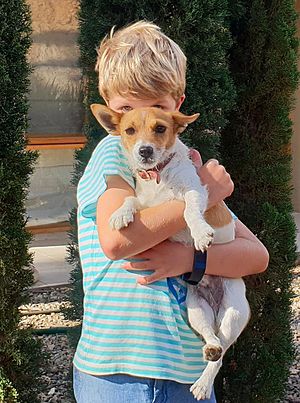
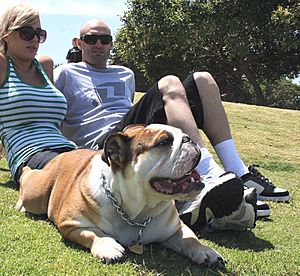
It is thought that about three-quarters of the world's dogs live in developing countries. These dogs are often feral (wild), village dogs, or community dogs. They are not usually kept as pets in these areas.
The number of pet dogs grew a lot after World War II. In the 1950s and 1960s, dogs were often kept outside. They were used as guard dogs, playmates for children, or companions for walks.
Today, most dog owners see their pets as part of the family. In the United States, there are an estimated 77.5 million people who own pet dogs.
A study in 2014 used magnetic resonance imaging (MRI) to compare humans and dogs. It showed that dogs react to voices in the same way humans do. They use the same parts of their brain. This means dogs can understand human emotions from sounds. This makes them friendly and social pets for people.
Best Dogs for Kids
The best dogs for kids usually have calm personalities. They are also happy to be social with everyone in the family.
Having a family dog can teach children about cooperation and responsibility. For example, a child can help with chores like walking, feeding, or brushing the dog.
Here are some popular dog breeds that are often good with kids:
- Cavalier King Charles Spaniel
- Cavoodle
- Cockapoo
- Labrador Retriever
- Schnauzer
- Pug
- Golden Retriever
- Bulldog
- Poodle
- Beagle
Dogs as Workers
Dogs do many jobs for people. They herd livestock like sheep. They help with hunting. They control pests like rodents. Dogs work as search and rescue dogs. They are also detection dogs, trained to find special items or substances. Dogs serve as home guards and police dogs (sometimes called "K-9s"). They are assistance dogs for people with disabilities. Some dogs even help fishermen with their nets. Others pull loads. In 1957, a dog named Laika was one of the first animals to travel into space. She went aboard the Soviet Sputnik 2.
Different kinds of service dogs help people with disabilities. These include guide dogs for the blind and hearing dogs for the deaf. Mobility assistance dogs help people with movement. Psychiatric service dogs help people with mental health conditions. Some dogs can even sense when a person with epilepsy is about to have a seizure.
Health Risks from Dogs
In 2018, the World Health Organization (WHO) reported that 59,000 people died globally from rabies. Most of these deaths were in Asia and Africa. Dogs are the main animal that spreads rabies. Dog bites affect millions of people each year. Children are often the main victims of dog bites.
Dog feces can contain eggs of Toxocara canis (dog roundworm). These can cause an infection called toxocariasis in humans. About 14% of people in the United States are infected with Toxocara. Untreated toxocariasis can harm eyesight. Dog feces can also contain hookworms. These can cause a skin condition in humans.
Health Benefits of Dogs
Having a dog can be good for human physical and mental health. Studies suggest benefits like fewer hospital visits. Dog owners may also take less medicine for heart problems and sleep issues. People with dogs tend to get more physical exercise. These benefits can last a long time. Owning a pet has also been linked to better survival rates for people with heart disease.
A 2005 paper in the British Medical Journal noted that children with pets missed less school due to sickness. Health benefits can come from contact with dogs in general, not just from owning them. For example, being around a dog can reduce stress. It can also expose people to helpful germs. These germs might protect against allergies and autoimmune diseases. Dogs can also provide social support.
One study showed that wheelchair users had more positive interactions with strangers when a dog was with them. Another study found that pet owners were more likely to build good relationships with their neighbors. New pet owners reported fewer minor health problems in the first month after getting a pet. This lasted for 10 months.
Using dogs and other animals in therapy has a long history. It dates back to the late 1700s. Animals were used in mental hospitals to help patients socialize. Animal-assisted therapy with dogs can make people with Alzheimer's disease smile and laugh more. Children with ADHD who participated in programs with dogs showed better attendance and skills. They also showed less antisocial behavior.
Dog Breeds
- See also List of dog breeds.
There are at least 800 different breeds (kinds) of dogs. If a dog's parents are both the same breed, the puppy will also be that breed. These dogs are called purebred or pure pedigree dogs. Dogs with parents from different breeds are not purebred. They are called mutts, mixed-breed dogs, hybrids, or mongrels.
Some popular breeds include sheepdogs, collies, poodles, and retrievers. It has become popular to breed two different dog breeds together. The new dog's breed is then given a name that mixes the parents' breed names. For example, a puppy with a poodle and a pomeranian as parents might be called a Pomapoo. These dogs are known as designer dog breeds. They are often used in prize shows or can even be guide dogs.
10 Cool Facts About Dogs
- There are hundreds of different breeds of dogs. There are about 400 million dogs in the world.
- Dogs have earned the nickname “man’s best friend.”
- The largest dog breeds include the Great Dane, Irish wolfhound, Scottish Deerhound, Neapolitan Mastiff, English Mastiff, Anatolian shepherd, Dogue de Bordeaux, Leonberger, and Boerboel. The smallest dog breed is the Chihuahua.
- The oldest dog ever lived was an Australian Cattle Dog from Australia named Bluey. He lived to be 29 years and 5 months old.
- A dog’s nose print is unique, just like human fingerprints. No two are the same.
- Dalmatian puppies are born completely white. Their spots appear as they grow, usually after 3 to 4 weeks.
- Dogs dream, just like humans do.
- Little dogs are often called toy dogs or lap dogs. This is because they are small enough to look like a toy and can easily fit on your lap.
- A dog is as smart as a 2-year-old child. They can recognize about 150 words and gestures.
- Dogs should not eat raisins, grapes, onion, chocolate, or garlic. These foods can make them very sick.
Images for kids
-
Location of a dog's carnassials; these teeth work like scissor blades.
-
A Golden Retriever chewing on a pig's foot.
-
Cerberus, a mythical three-headed dog, from Dante's Third Circle of Hell. Painting by William Blake.
See also
 In Spanish: Perro para niños
In Spanish: Perro para niños



